UPDATE 3/6/14: Elizabeth has a new book coming out March 25…Living Life in Full Bloom: 120 Daily Practices to Deepen Your Passion, Creativity & Relationships
UPDATE 12/8/13: Elizabeth has just announced that her new book, Living Life in Full Bloom, will come out 3/25/14. She says it’s been a three year process of love, devotion and discipline.
By Pamela Burke/November 18, 2010
Elizabeth Murray is a professional gardener and artist to name but a few of her many talents. This modern day Renaissance woman has just updated and republished her fascinating book “Monet’s Passion: Ideas, Inspiration, & Insights from the Painter’s Gardens.”
In 1984 Elizabeth up and quit her job to live and work at one of the most beautiful places in the world, Monet’s Giverny. She returns each year with pencil and camera to recapture the garden’s splendor. Her photographs are breathtaking.
“Something led me to Monet and to be at Giverny. I needed to learn, to contribute, to try to make the gardens even more spectacular.” Elizabeth
Giverny is one of my most favorite places on earth. After I heard Elizabeth speak about her adventures at Monet’s home, I needed to learn more about his incredible garden and the unique relationship she has with it.
How she ended up there was a tale I had to hear her tell…
EYE: You’re an artist, an author, painter, photographer, gardener, and a naturalist. You teach workshops and give lectures. Would you say that you’re a Renaissance woman?
 ELIZABETH: Some people have called me that as a compliment. In some ways it’s true. I’m passionate about creativity, beauty, and love. Nature is number one to me so a garden is a way to be an artist and be sacred with plants.
ELIZABETH: Some people have called me that as a compliment. In some ways it’s true. I’m passionate about creativity, beauty, and love. Nature is number one to me so a garden is a way to be an artist and be sacred with plants.
It’s important to have a relationship with plants. You meet people around the world who have love and respect for them. If you’re in France or the Amazon Jungle or the Andes, you recognize the vibration and beauty of the plants or trees or flowers.
You begin to understand them. They all have different personalities and give you different things.
EYE: Were you always creative? When did you know?
ELIZABETH: I’ve felt this way since I was a child. I would steal flowers and sell them back to the neighbors when I was five or six. My mom showed me how to make cuttings. I’d make a little hedge around the playhouse.
The gardens then were wild with plums and orchids. You could swing on the ivy and pick the lilac. I had no supervision since before I was in kindergarden. We roamed the hills with great freedom.
It’s important that children have free time like I did. They have 45 hours of screen viewing time now a week and only 30 minutes of unscheduled play outside. How do kids get their imagination? How will they learn to invent things? What will they respect?
[vimeo http://http://vimeo.com/2189388#embed]
For me, it’s about falling in love and what you love. You know the special feeling that’s imprinted when you have a value or a comfort or a great memory. We need to connect children to nature to give them these qualities.
EYE: You gave it all up and went to work in Monet’s gardens for free for nine months in the 1980s. What possessed you? Did you pinch yourself when you were there?

ELIZABETH: I had a job at the time, but I went to Europe to get inspired. Going to Monet’s garden at Giverny made me tell myself that I wanted to quit my job at home. I had never seen so many flowers with such romance. They were connected to an artist that I have so much respect for.
I’m a gardener and an artist. Something led me to Monet and to be at Giverny. I needed to learn, to contribute, to try to make the gardens even more spectacular.
“I went in a new direction to nurture, inspire and cultivate myself…I would give to the garden and it would give to me.”
EYE: Were you nervous about the decision?
ELIZABETH: Totally. It was impractical. I could have bought a house. I was a very well paid gardener with nine people working with me; I had health insurance and paid vacations and could do whatever I wanted.
I went in a new direction to nurture, inspire and cultivate myself. I felt I could contribute to something that was worthwhile. I would give to the garden and it would give to me.

After nine months, I think the place impacted me more than me to it. I helped restore some of the trees and wisteria and introduced new ways of pruning roses, but I was certainly not in a position of great power. I tried to inspire the gardeners there. Gardeners need to know how great they are.
“The magic is that the garden is Monet’s…He was really quite an extraordinary visionary.”
EYE: How special is the garden? It’s been called a “never-ending feast for the eye.”
ELIZABETH: The magic is that the garden is Monet’s. We would not give it as much attention if not for him. He fell in love with it because of the quality of light. There was a lot of love going into the garden. He lived there for 46 years and was an indigenous person on that land. There is quite a vibration from him there.
He was really quite an extraordinary visionary. There is a vibration of intention, a power of the land. There’s a quality that we feel of love and respect.
EYE: What’s your favorite flower in the garden?
ELIZABETH: My favorite is usually what’s in bloom. I love the pink roses trained that rise above all the other flowers. A climbing rose is grafted onto a rose rootstock. That climber is then trained onto a piece of metal in the shape of an umbrella. They’re underplanted with peonies and iris.
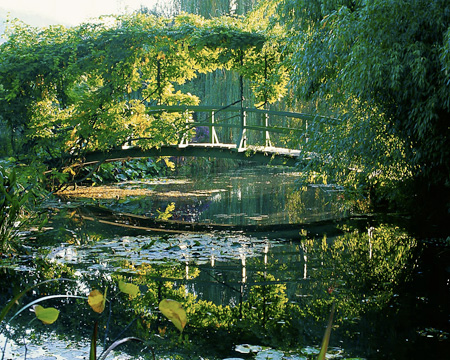
The Grand Allee is beautiful. In autumn there are lots of beautiful asters that are eight feet tall and gorgeous dahlias. There is nothing like the water garden when the wisteria is in bloom. It doesn’t last that long.
EYE: Is gardening a form of art for you?
ELIZABETH: Gardening is the art that uses flowers and plants as the paint and the soil and sky as the canvas. Monet’s garden is always changing and inspiring. Some times are better than others. It’s beautiful in the spring. The irises and roses are spectacular then.
I photograph it every time I go trying to improve myself as a photographer. I look at it with a new eye. Sometimes I get out in the boat to see the plantings near the edge of the bridge. Getting in the water is wonderful.
EYE: You’ve just updated your book. What did you add to it?
ELIZABETH: This is the first update in 20 years. It’s all been rewriten with new illustrations, research, and the plant list which I translated from the French names. It was harder to write the second time as I had the experience of 25 years in the garden.
There are many books about the artist, but this one is just about the garden and what the garden did for Monet. The garden was a muse for him.
EYE: He seems to be your muse. What did his garden teach you?
ELIZABETH: He is a muse for me. I lectured recently and showed my garden for the first time. I don’t base my garden on flowers like Monet. He said if it weren’t for flowers, he wouldn’t be a painter. He had to have flowers always; he sold paintings to have a garden.
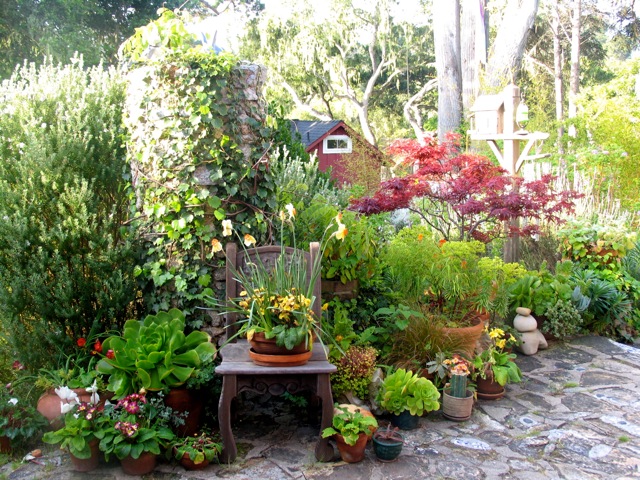
It fed him so that he could paint. I’m hoping my garden will be that way eventually, and that it will inspire me to paint. I’m already teaching in it. I want to have a big relationship with my garden, to know quality of light and what time of day to paint. When you know a place, it can call to you.
EYE: What do you do when you need inspiration?
ELIZABETH: I travel and rent spaces. I rented a little room in a village by the sea in Normandy once. I needed to go to France to go deeper. I spent six months living very simply so that the light would call me.
I began writing and developing my photography. There was no phone and no car so I was able to write two books and feed myself with nature and beautiful gardens.
EYE: Can everyone have a Giverny that’s a place for creativity?
ELIZABETH: Obviously it’s more challenging if you live in an apartment. But even if it’s a small patio, you have the opportunity to create something of beauty with plants in a space you feel nurtured by and you then nurture it back.
It will feel like small sanctuary that will connect and inspire you to paint, sit or meditate. You can watch the light. You can be quiet, breathing in and out the light and beauty. You become rooted to the land.
“I find appropriate places for people that create meaning and try to find out how a garden can nurture them.”
EYE: Are gardens healing spaces? Is yours?
 ELIZABETH: Yes! I wrote a book called “Cultivating Sacred Space: Gardening and the Soul, ” where I talk about this. I do some consulting in hospitals and have made gardens for people with terminal cancer. I find appropriate places for people that create meaning and try to find out how a garden can nurture them.
ELIZABETH: Yes! I wrote a book called “Cultivating Sacred Space: Gardening and the Soul, ” where I talk about this. I do some consulting in hospitals and have made gardens for people with terminal cancer. I find appropriate places for people that create meaning and try to find out how a garden can nurture them.
I know when I’ve been through difficulty or great grief that the garden centers me. When I don’t have the energy to plant or grieve, I just arrange flowers. They give me energy. It’s healing to put them in the house.
EYE: What are some of your own favorite paintings?
ELIZABETH: I’m hanging them for a show now. In my dining room I have the landscapes. The cliffs of Big Sur where the land meets the sea are one of my favorite scenes to paint.
In other rooms I have my photography, the still lifes and photos of Monet’s garden. On one wall I have my painterly photography and on another my garden paintings.

EYE: You say you fall in love all the time. Explain.
ELIZABETH: I used to be embarrassed by it. I can live here, there, anywhere that I see something that I am attracted to. Part of this is having an open heart and a sense of gratitude whether it’s a place, beauty, color, or a renewable resource. I love my house and garden.
I want the eye to be connected to the heart and that awe, that lump in the throat when I said I would give up my job and work free when I first went to Monet’s garden.
EYE: If you hadn’t gone to Giverny, would you be the same person?
ELIZABETH: No. It had a big impact on me. My stay with the indigenous people of the Ecuadorian Amazon Jungle had a big impact as well. It’s comforting to be in a place where there has been no violence to nature and where trees are deeply respected as ancestral beings.
When I was recognized as a medicine woman by a shaman, I received a new sense of clarity and opportunity. There are modern ways to be a medicine woman. I ask myself how I can use that creativity now. I think by awakening, connecting, inspiring, and keeping a vitality.
Modern medicine women with real responsibility stay rooted. You know where you’re at. You take a position of integrity. It’s not about money or what sells. It’s about what’s good, true, and beautiful. We must stay connected to the spirit and the land.
EYE: Were you always this centered?
ELIZABETH: It’s not easy to be centered all the time. When I was in my teens, I meditated with the Quakers-Society of Friends and then the Zens, working with them on social justice and peace issues. Part of being centered is going through great grief and loss. If you can get through that with love, you don’t get embittered. Your heart may be broken open but there’s a a tiny something holding it together. The gold from love fills it in.
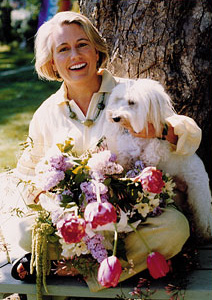 There are so many heart-breaking things happening now. The question is how to be vulnerable, open, and hold a sense of justice. Vulnerability lets us cry for the beauty of day and not fall apart.
There are so many heart-breaking things happening now. The question is how to be vulnerable, open, and hold a sense of justice. Vulnerability lets us cry for the beauty of day and not fall apart.
EYE: I’m always interested in what the eye sees. What is a creative eye to you?
ELIZABETH: My mother trained my eye. I have to be connected to the heart and the spirit. The eye keeps me in awe and wonder. It’s directly connected to gratitude and surprise.
It’s about saying loudly “Look at that light going through the trees!!!” Then you ask yourself with all this inspiration, what am I going to do with it. It has to filter. And of course, there are skills involved.
It’s also about courage and that comes from the heart again. In some of the paintings that I love the best, I can feel the courage of what it took to do them. The artist makes a difference. It takes a lot of courage to be creative and then to live that life. You have to believe in yourself and know that it’s all worthwhile.
EYE: Thanks so much for this conversation, Elizabeth. You give the eye a brand new meaning!
UPDATE: 1/18/11–Elizabeth is launching the Green Heart Guild with a new website soon. She’ll be teaching five new workshops at her home and gardens. The guild will later expand to more teachers, subjects and places. The courses are about everything that connects us to Heart, Nature and Spirit with Play she says. Check out her current website for more info.
An article Elizabeth recommends on Monet’s Garden: Lasting Impressions, Claude Monet

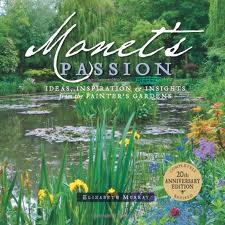


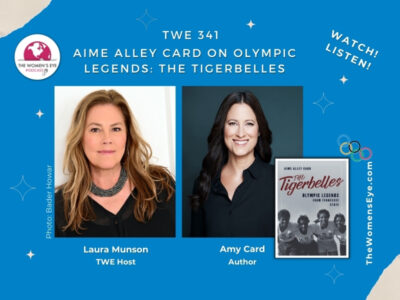

Leave a Reply